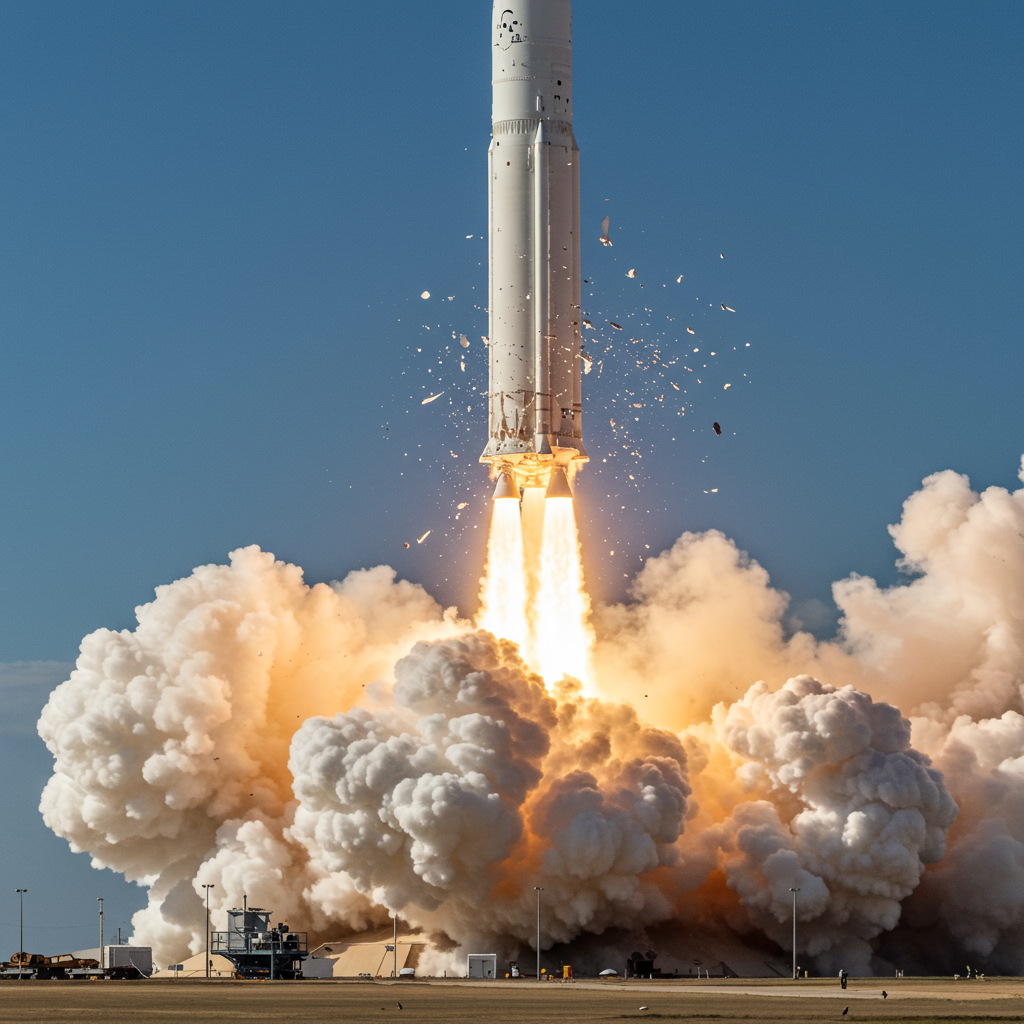NASA’s Space Launch System (SLS) rocket, the cornerstone of America’s ambitious Artemis program aimed at returning astronauts to the Moon, recently faced a significant setback during testing, further highlighting the challenges and uncertainties surrounding its future.
Just days after a successful test of a new RS-25 liquid-fueled engine, designed to power later SLS missions, a crucial test of a next-generation solid rocket booster ended dramatically when its nozzle disintegrated during firing. These tests are vital for the program’s continuation, yet they occur against a backdrop of exceptionally high costs per launch and ongoing political pressure favoring cheaper commercial spaceflight alternatives.
Mixed Results from Propulsion Tests
NASA and its contractors recently conducted two key propulsion tests crucial for the Space Launch System’s evolution:
- Next-Gen RS-25 Engine: Last week, a new RS-25 engine, the first produced since the Space Shuttle era concluded, underwent a successful test at NASA’s Stennis Space Center. This engine, designated No. 20001, is slated for use on the fifth SLS flight, Artemis V. Manufactured by L3Harris (which acquired Aerojet Rocketdyne), this test marked the reactivation of the RS-25 production line after a decade-long hiatus and billions in investment. The engine performed as expected, exceeding Shuttle-era power levels by reaching 111 percent of rated thrust during the 500-second acceptance test. Notably, NASA chose to conduct this significant test with unusual discretion, foregoing a public livestream and delaying a public statement, perhaps reflecting the political uncertainty about whether this engine will ever fly if the program is curtailed.
- Advanced Solid Rocket Booster: This week, NASA and Northrop Grumman test-fired a prototype of a new solid rocket booster design in Utah. This booster is part of the Booster Obsolescence and Life Extension (BOLE) program, intended to introduce higher-performance boosters for SLS missions starting with Artemis IX. The new design incorporates modern features like lighter carbon-fiber composite cases (replacing steel), an electronic steering system (replacing hydraulics), and a different propellant mix. Touted as the “largest and most powerful segmented solid rocket motor ever built for human spaceflight,” this test unit generated an impressive 3.9 million pounds of thrust. However, approximately 100 seconds into the burn, things went wrong: an uncontained plume of exhaust appeared near the nozzle, followed moments later by the violent disintegration of the nozzle itself. The booster continued firing uncontrollably until its propellant was expended, even sparking a fire.
This nozzle failure is particularly concerning as Northrop Grumman has experienced similar issues in recent years, including during tests for its Omega rocket and a booster used on a United Launch Alliance Vulcan flight last year.
The Cloud Over SLS’s Future
The technical challenges highlighted by the booster test occur alongside significant programmatic hurdles for the SLS. The rocket was originally pitched as a cost-effective way to leverage existing Space Shuttle hardware, but development delays and ongoing production costs have ballooned its price tag. Each Artemis mission using the SLS currently costs an estimated $4.2 billion, even utilizing remaining Shuttle-era engines and booster parts.
While NASA possesses enough leftover Shuttle main engines for the first four SLS flights and components for eight pairs of boosters, the new production lines are essential for missions beyond that. However, the cost of these new components is substantial; new RS-25 engines, for instance, are priced around $100 million each, far exceeding the cost of comparable commercial engines like SpaceX’s Raptor or Blue Origin’s BE-4.
Adding to the pressure is the political landscape. The previous administration expressed a desire to cancel SLS after just three flights in favor of commercial alternatives, and while preliminary congressional proposals might extend its guaranteed life to five missions, reaching nine flights by 2040 is considered unlikely. The White House continues to signal a preference for cheaper, commercially developed solutions for deep space transport where possible.
This isn’t just hypothetical; NASA has already transitioned a major science mission, the Europa Clipper probe, from a congressionally mandated SLS launch to a commercial Falcon Heavy launch due to SLS delays, despite the commercial option requiring a significantly longer transit time via gravity assists.
A Tale of Two Development Philosophies
The situation underscores a fundamental difference in approach between NASA’s government-led, cost-plus contracting model for SLS and the iterative, “fly-fast, fail-fast” approach common in the commercial sector, exemplified by companies like SpaceX and Blue Origin.
While SLS is a “boutique machine” with a slow flight rate and operating in a “hardware-poor” environment (few units available), commercial providers operate in “hardware-rich” environments that allow for numerous test flights and rapid learning from failures – even significant ones like recent Starship upper stage explosions during testing or partial failures during launch attempts. This iterative process, while sometimes messy, is crucial for quickly identifying and resolving issues to improve reliability.
Furthermore, the need for robust commercial launch options is critical as NASA increasingly relies on the private sector. Dependence on a single system or provider is seen as risky, highlighting the value of healthy competition and redundancy offered by multiple players in the market.
While the Space Launch System remains essential for the near-term Artemis missions, particularly given its current role in launching the Orion crew capsule, the recent booster test failure serves as a stark reminder of the technical hurdles ahead. Combined with the persistent cost challenges and political preference for lower-cost commercial solutions, the long-term trajectory and flight frequency of the SLS rocket program appear increasingly uncertain.




